Seasons in Spanish || All Four Seasons PLUS Cultural Insights
How to Talk About All Four Seasons in Spanish & Spend Them Like a True Spaniard 🌸☀️🍂❄️
Sunny Spain. Spain boasts of 3,000 hours of sunlight on average per year, with temperatures being mild and temperate in general. That probably explains why Spain is a favourite tourist destination.

Either way, Spain has four distinct seasons and it helps to be able to talk about all four of them in Spanish.
Spring and Autumn are the crowd favourites as temperatures are very pleasant and not too extreme, so you can enjoy being outdoors more often.
During the summer, the heat can be pretty intense and in the winter, it’s time to dress up like an onion (layers and layers of clothing).
👉 So in this blog, we’re going to teach you all the relevant words, phrases and cultural insights you need to navigate all four seasons in Sunny Spain!
Let’s break down the seasons, or estaciones
Seasons in Spanish || Basic Seasonal Vocabulary
Seasons in Spanish || Spring in Spain, Everyone’s Favourite
Seasons in Spanish || Summer in Spain
Seasons in Spanish || Autumn, the Perfect Transition
Seasons in Spanish || Winter in Spain
Seasons in Spanish || FAQs
Seasons in Spanish || Basic Seasonal Vocabulary
Here are the basics. Season in Spanish, when referring to the four weather seasons as a meteorological event is estación . So, the four seasons ( las cuatro estaciones ) in Spanish are:
| Spanish | English |
|---|---|
| Primavera | Spring |
| Verano | Summer |
| Otoño | Autumn |
| Invierno | Winter |
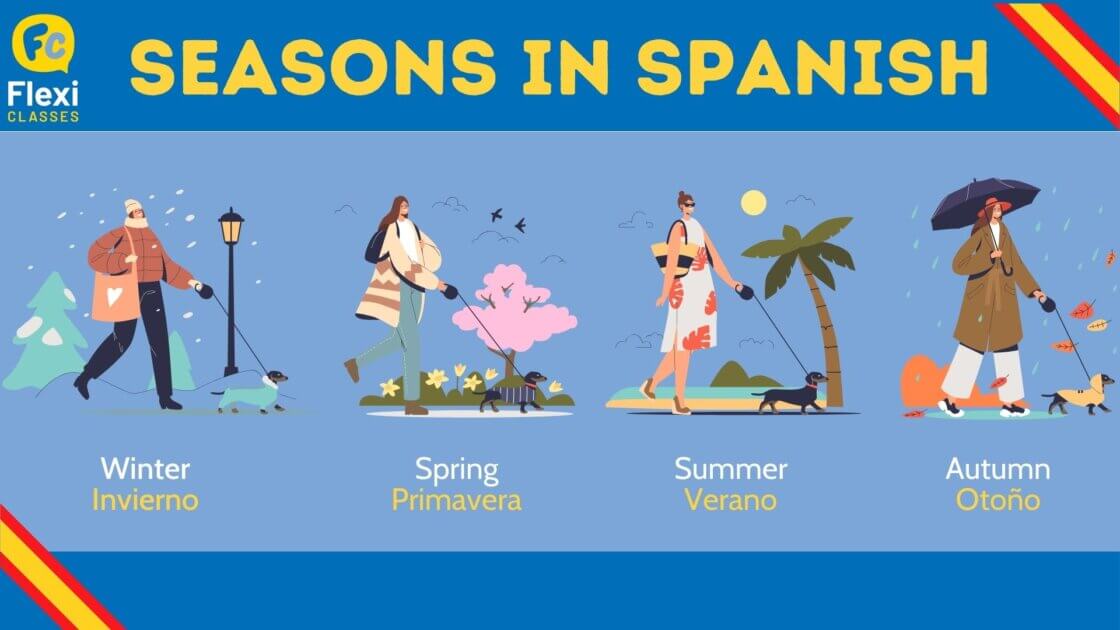
Season can also translate to temporada, which refers to a time period within a particular season or a season(al) related event. For instance, when referring to:
– a period of time during a season: summer time – la temporada de verano
– a weather phenomenon: storm season – la temporada de tormentas ,
– a weather-related event: skiing season – la temporada de esquí ,
– a seasonal activity: hunting season – la temporada de caza ,
– or even a harvest-weather event: mushroom season – la temporada de setas .
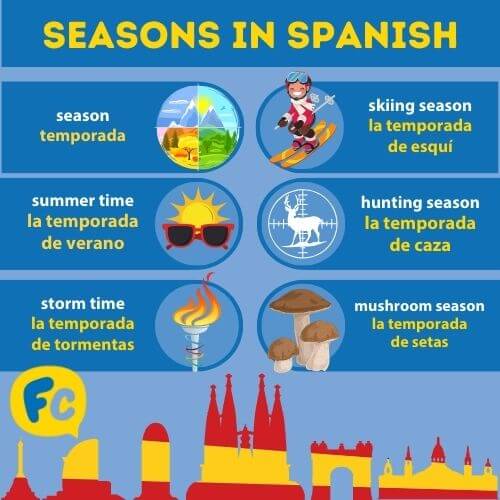
🔎 A tip: Seasons in Spanish are not capitalized and are all in the masculine form, except for spring, which is feminine. La primavera (spring), el verano (summer), el otoño (autumn), el invierno (winter).
Seasons in Spanish || Spring in Spain, Everyone’s Favourite
Spring, almost everyone’s favourite season in Spain, typically commences on March 20 and extends up to June 21. It is a lovely season with pleasant, mildly warm temperatures, an average of 13.5 degrees Celsius.
Amidst the thawing and blooming and the sun taking centre stage, it is perfect for taking outdoor strolls, trips to nature or just an afternoon on a sidewalk terrace or a park bench – with the bonus of wearing lighter clothing and ridding yourself of all of those winter textile layers.
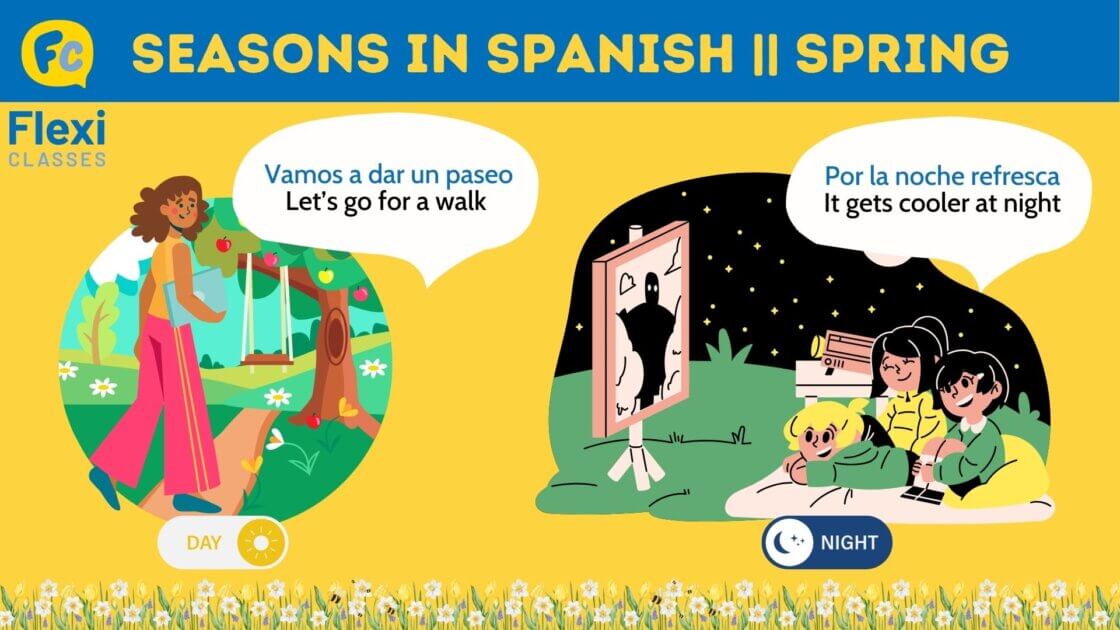
Suddenly outdoor terraces mushroom, ice-cream stands pop up and people flock to the streets, changing the dreary winter urban landscape to a more jubilant and uplifted one. You can literally feel spring in the air.
A word of notice though. As forebodes the well-known Spanish spring idiom, En abril, aguas mil (‘In April, a thousand showers’), be on the lookout for those transient and frequent rain showers that can catch you off guard during the spring.
And for your absolute spring enjoyment, here are some frequently used spring words:
| Spanish | English |
|---|---|
| Hace sol | It’s sunny (note that sol can interchangeably as well refer to the ‘sun’ (‘The sun is out’ – Ha salido el sol) |
| Llueve | It’s raining |
| Brisa | Breeze |
| Temperatura agradable | Pleasant weather |
| Por la noche refresca | It gets cooler at night |
| Dias más largos | Longer days |
| Chaqueta de entretiempo | Light summer jacket |
| Alergias de primavera | Spring allergies |
| Cambio de armario | Change of wardrobe (referring to the seasonal change of wardrobe in the winter-to-spring transition) |
| Vamos a dar un paseo | Let’s go for a walk |
| Flores | Flowers |
Seasons in Spanish || Summer in Spain
Summer typically commences on June 21 and extends up to September 23. During the summer, temperatures can range between 20 to more than 30 degrees Celsius.
The heat intensity and the dryness or humidity you will experience are highly dependent on which part of Spain you are in. For example:
– In the north (Galicia, Cantabria, etc.) temperatures can be significantly lower and rain showers are frequent;
– In the Meseta area (inland, Central Plateau), the climate is very dry;
– And along the (huge) coastal area, the weather is milder and much more humid.
And speaking of coasts, Spain boasts having some of the most beautiful beaches in Europe.
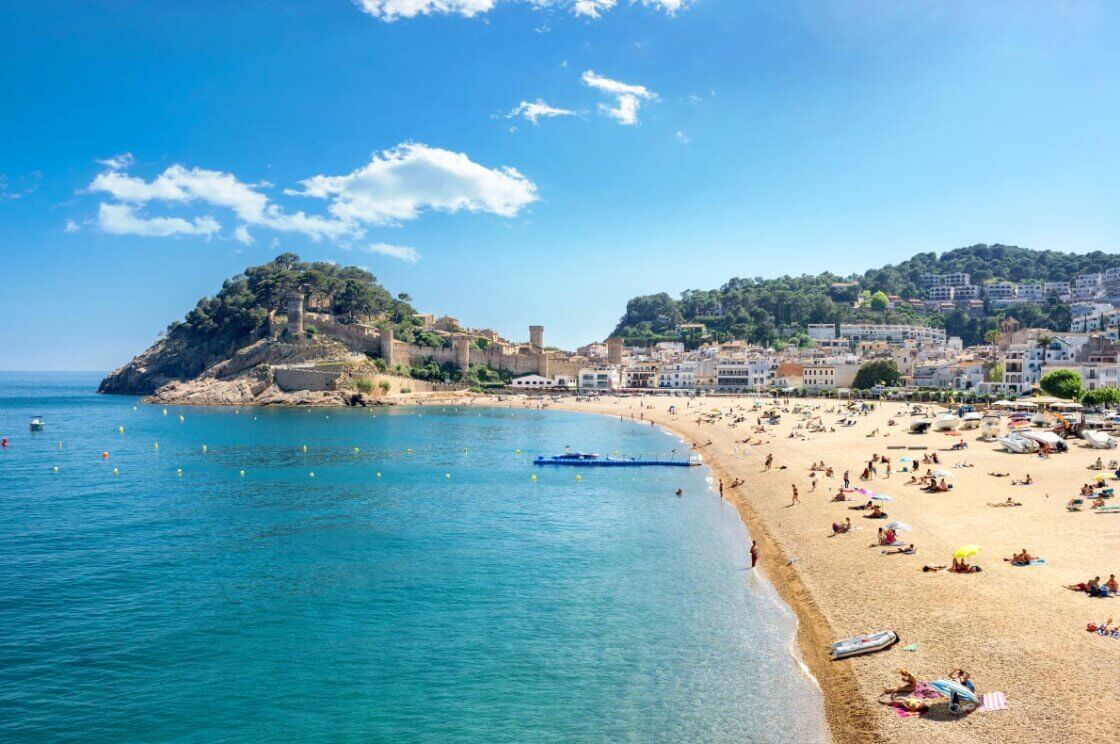
So, for your Spanish summer choice of wardrobe, you will need light-colored and thin textured clothing, a pair of sunglasses, a summer hat and swimwear to enjoy those long hours of sun, world-renowned beaches, quaint summer towns and beautiful countryside.

🔎 A tip: Spare some energy as you might want to attend one of the many summer festivals happening all over Spain.
Here are some basic summer terms that will come in handy when in Spain:
Noches de verano – Summer nights
Festival de música – Music festival
Traje de baño – Bathing suit
Gafas de sol – Sunglasses
Una caña por favor – A small (glass) of draft beer, please
Vamos a la playa – Let’s go to the beach
Época de verano – Summer time
Estamos cerrados por vacaciones – We are closed for vacations
¡Qué calor! – It’s so hot!
Chiringuito de playa – Beach bar
Tomar el sol – Sunbathe
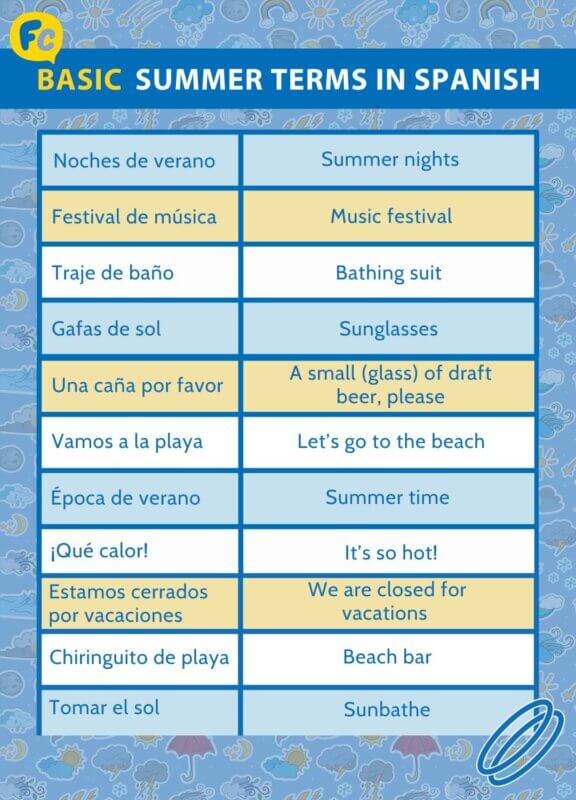
Seasons in Spanish || Autumn, the Perfect Transition
Autumn typically commences on September 23 and extends up to December 21. Autumn is a great respite from the unrelenting Spanish summer heat.
Temperatures begin to drop in preparation for the winter but still, most days are sunny and the weather is pleasant, not too cold, not too warm (average temperature is around 15.5 degrees Celsius).
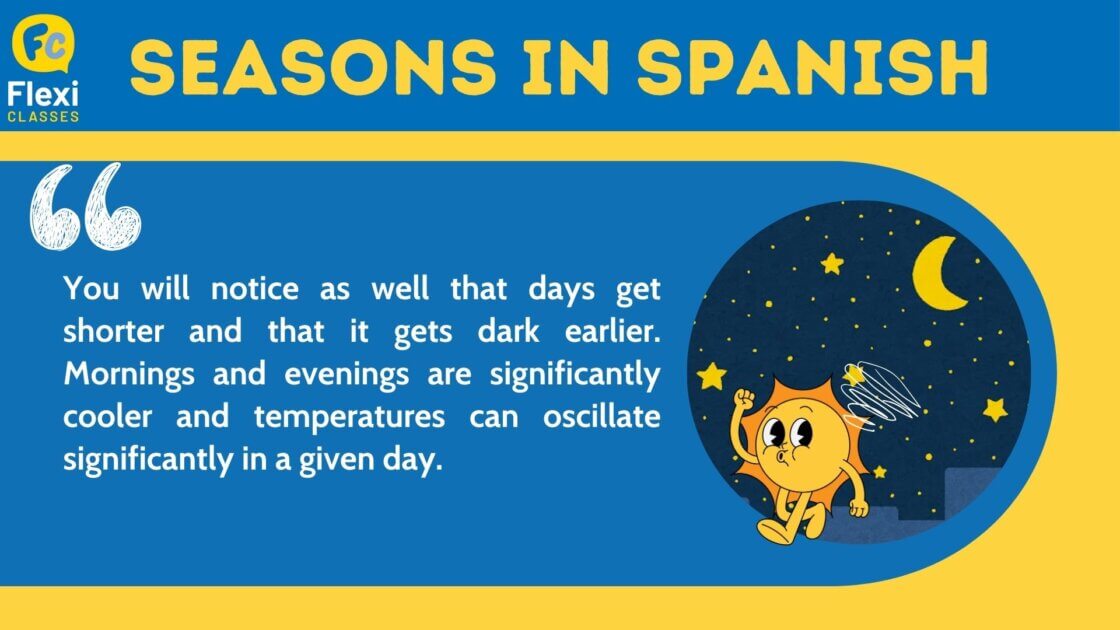
A phrase you will often hear during this season due to the changing temperatures throughout the day is ¡No sé que ponerme! (I don’t know what to wear!).
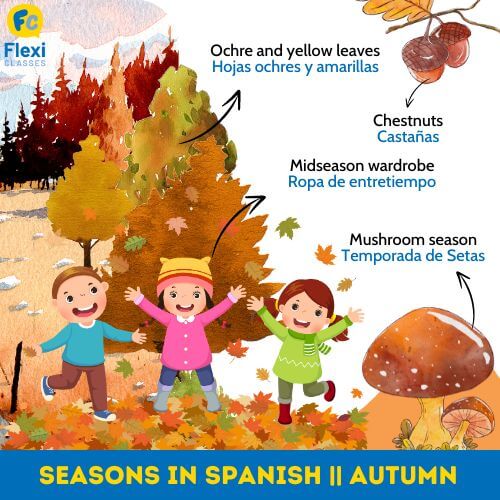
🔎 A tip: November has traditionally always been the rainiest month of Autumn in Spain, so remember to carry a small umbrella with you, it might be a lifesaver.
Autumn in Spain is synonymous with chestnut roasting, mushroom season, ochre and yellow leaves, pre-Christmas shopping, wine harvesting season…
So here are some useful Spanish autumn words:
| Spanish | English |
|---|---|
| Hace fresco | It’s cooler |
| Está nublado | It’s cloudy |
| Los días se hacen más cortos | Days are getting shorter |
| Oscurece antes | It gets dark earlier |
| Castañas | Chestnuts |
| Temporada de Setas | Mushroom season |
| Hojas ochres y amarillas | Ochre and yellow leaves |
| Fiesta de la vendimia | Wine harvest festival |
| Compras prenavideñas | Pre-Christmas shopping |
| Ropa de entretiempo | Midseason wardrobe |
To learn more about Ways to Say Hi, check out this!

8 Ways to Say Hi in Spanish – Say Hello Like a Local
Different Ways of Saying Hi in Spanish, Fit for Each Occasion! There are many ways to say hello in Spanish, based on several factors… Is it a formal or an informal occasion? Are you close friends or have you just…
Seasons in Spanish || Winter in Spain
Winter typically commences on December 21 and extends up to March 21. Due to Spain’s geographical location, winter is generally not as extreme nor as rainy as in other European countries but still, these are the coldest months of the year.
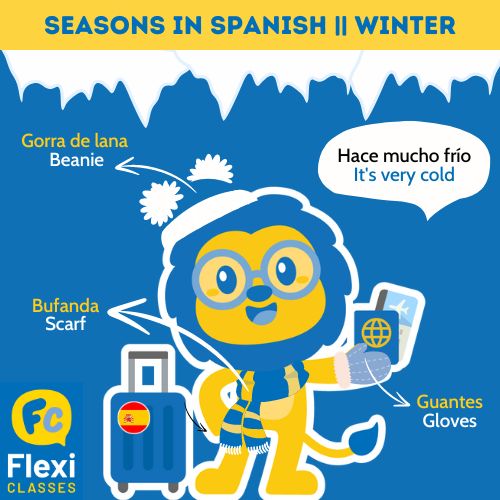
Winter in Spain can be very varied. Temperatures drop and some areas get covered with snow while other areas are more humid and enjoy a milder winter.
For instance, in the north of Spain, you will experience lower temperatures and more rain. In the Meseta area (inland), always expect a drier climate and more extreme and colder temperatures in comparison with the coastal areas, where it hardly ever snows and winters are placidly warmer.
🔎 A tip: If you want to enjoy summer-like weather during the winter, you can always scoot down to the Canary Islands, where the average year-round temperature is 24 degrees Celsius.
For some winter savviness, here are some Spanish winter terms that can come in handy.
| Spanish | English |
|---|---|
| Nieve | Snow |
| Hace mucho frío | It’s very cold |
| Temporal de nieve | Winter storm |
| Abrigo de invierno | Winter coat |
| Jersey de lana | Wool sweater |
| Guantes | Gloves |
| Bufanda | Scarf |
| Temporada de esquí | Ski season |
| Abrígate | Bundle up / wear warm clothes |
| Chimenea | Chimney |
| Cierra la ventana | Shut the window |
| Enciende la calefacción | Turn on the heater |
| Época de navidad | Christmas season |
Want More From LTL?
FANCY LEARNING SPANISH? Check out our online Spanish courses here.
We offer a 7-day free trial to all online students where you can study Spanish 24/7. It doesn’t end there either.
We teach over 10 of the world’s most popular languages 😎
Come and be a part of our amazing community.
Seasons in Spanish || FAQs:
What type of weather does Spain have?
As Spain enjoys an average of 3000 hours of sunlight a year, the Spanish climate is generally mild and temperate, especially in comparison to other European countries.
Temperatures will vary based on each season and location, summers being warmer and drier inland and more humid and temperate in the coastal areas and winters being colder and more extreme inland and milder along the coast.
Does it snow in Spain?
Yes, it does! Contrary to what is generally believed, Spain is a very mountainous country. So, if you’re up for winter sports, some of the most well-known destinations are the Pyrenees and Sierra Nevada (Granada).
What month does Spain take off?
Most Spaniards take off for vacations during the summer season, traditionally during August. The bigger cities and towns empty out, as locals generally leave en masse for the coast, the mountains or the countryside.
What is the best time to visit Spain?
Anytime, as all seasons boast of plenty to offer!
Seriously though, weather-wise, aim for early spring (April-May) or early Autumn (September-October) – which will allow you to spend more time outdoors, comfortably visit more locations and enjoy mild temperatures and sunny days.
Does Spain have four seasons?
Yes, Spain is geographically located in the Northern Hemisphere, so it enjoys the full scope of the four seasons (winter, spring, summer and autumn).
As Spain is known to be the most climatically diverse country in Europe, expect a lot of variation in the climate within the seasons, especially depending on which part of Spain you are in.









